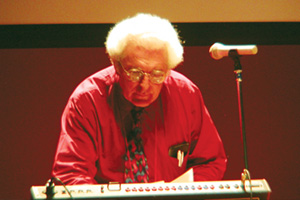Making it personal
As the tools of visual art and design have increasingly moved to the
digital, Moog's description of the situation of electronic musical instruments
and the challenge for their design provides an enlightening analogy.
In playing pre-electronic instruments, musicians rely on multiple modes
of feedback and control to and from the instrument in a complex and data-intensive
information flow. Vibrating strings and force feedback of pressure allow
musicians subtle adjustments to the notes before a sound is made, reaching
a state of such close connection to the instrument that they feel it
is an extension of their own body. Electronic instruments, while offering
precise and complete control for the musician, give no tactile feedback
of what the effect of the hand will be on the result before the sound
is made. Moog's work on the synthesizer centers around bringing tactile
feedback into interfaces for digital instruments. Reaching a critical
mass of control to create the feeling in the musician that the instrument
is an extension of their body, allowing them complete control at a pre-conscious
level is crucial for digital instruments to become as powerful as traditional
analog ones: Mr. Moog's presentation points to the need to included rich
tactile, and sensory information in tools for creative artists, whether
audio or visual.(GW)
|
 |
 |
